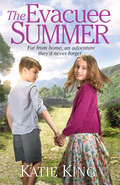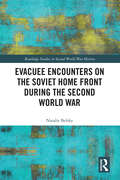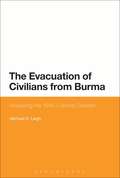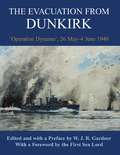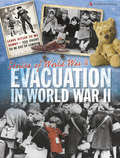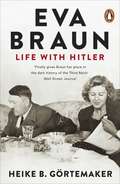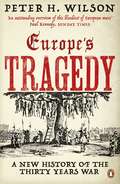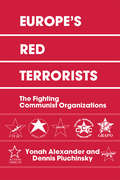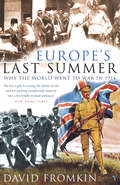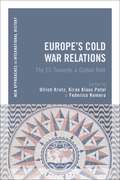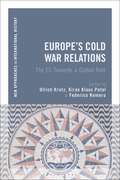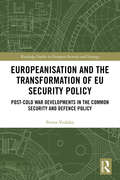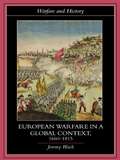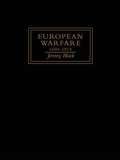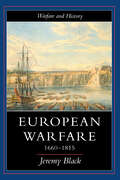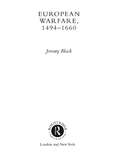- Table View
- List View
The Evacuee Summer
by Katie King‘A heartwarming read’ My Weekly ‘A delightful, nostalgic read’ Woman Magazine Far from home, an adventure they’ll never forget…
Evacuee Encounters on the Soviet Home Front During the Second World War (Routledge Studies in Second World War History)
by Natalie BelskyThis study is the first to examine the experiences of the millions of Soviet civilians evacuated to the interior of the country during the Second World War in the context of their encounters and relations with local communities and populations across Soviet Central Asia, Kazakhstan, Siberia, and the Urals. The book considers the impact of this episode of massive population displacement across Eurasia on individuals, communities, and society more broadly. It explores how the challenges associated with wartime displacement gave rise to tensions between evacuees and local residents. These frictions, in turn, forced individuals to interrogate the meaning, terms, and limitations of citizenship and belonging in the Soviet Union. Evacuation thus played a critical role in the changing relationship between citizens and the Soviet state in the war and postwar periods. Furthermore, this study pays particular attention to the plight of Soviet Jewish evacuees, who constitute the largest contingent of Holocaust survivors in Europe, and the rise of anti-Semitism on the Soviet home front during the war. This volume will be of interest to students and scholars of the Second World War, migration and displacement, the Holocaust, Soviet Jewish history, and the Soviet experience more broadly.
Evacuee Encounters on the Soviet Home Front During the Second World War (Routledge Studies in Second World War History)
by Natalie BelskyThis study is the first to examine the experiences of the millions of Soviet civilians evacuated to the interior of the country during the Second World War in the context of their encounters and relations with local communities and populations across Soviet Central Asia, Kazakhstan, Siberia, and the Urals. The book considers the impact of this episode of massive population displacement across Eurasia on individuals, communities, and society more broadly. It explores how the challenges associated with wartime displacement gave rise to tensions between evacuees and local residents. These frictions, in turn, forced individuals to interrogate the meaning, terms, and limitations of citizenship and belonging in the Soviet Union. Evacuation thus played a critical role in the changing relationship between citizens and the Soviet state in the war and postwar periods. Furthermore, this study pays particular attention to the plight of Soviet Jewish evacuees, who constitute the largest contingent of Holocaust survivors in Europe, and the rise of anti-Semitism on the Soviet home front during the war. This volume will be of interest to students and scholars of the Second World War, migration and displacement, the Holocaust, Soviet Jewish history, and the Soviet experience more broadly.
The Evacuation of Civilians from Burma: Analysing the 1942 Colonial Disaster
by Michael D. LeighThe string of military defeats during 1942 marked the end of British hegemony in Southeast Asia, finally destroying the myth of British imperial invincibility. The Japanese attack on Burma led to a hurried and often poorly organized evacuation of Indian and European civilians from the country. The evacuation was a public humiliation for the British and marked the end of their role in Burma.The Evacuation of Civilians from Burma investigates the social and political background to the evacuation, and the consequences of its failure. Utilizing unpublished letters, diaries, memoirs and official reports, Michael Leigh provides the first comprehensive account of the evacuation, analyzing its source in the structures of colonial society, fractured race relations and in the turbulent politics of colonial Burma.
The Evacuation of Civilians from Burma: Analysing the 1942 Colonial Disaster
by Michael D. LeighThe string of military defeats during 1942 marked the end of British hegemony in Southeast Asia, finally destroying the myth of British imperial invincibility. The Japanese attack on Burma led to a hurried and often poorly organized evacuation of Indian and European civilians from the country. The evacuation was a public humiliation for the British and marked the end of their role in Burma.The Evacuation of Civilians from Burma investigates the social and political background to the evacuation, and the consequences of its failure. Utilizing unpublished letters, diaries, memoirs and official reports, Michael Leigh provides the first comprehensive account of the evacuation, analyzing its source in the structures of colonial society, fractured race relations and in the turbulent politics of colonial Burma.
The Evacuation from Dunkirk: 'Operation Dynamo', 26 May-June 1940 (Naval Staff Histories)
by W.J.R. GardnerThis is the Naval Staff History of "Operation Dynamo", originally published internally in 1949. British ships evacuated nearly 100,000 men of the BEF from the beaches, and over 200,000 from harbours. Other nations' vessels carried more than 30,000.
The Evacuation from Dunkirk: 'Operation Dynamo', 26 May-June 1940 (Naval Staff Histories)
by W.J.R. GardnerThis is the Naval Staff History of "Operation Dynamo", originally published internally in 1949. British ships evacuated nearly 100,000 men of the BEF from the beaches, and over 200,000 from harbours. Other nations' vessels carried more than 30,000.
Evacuation: Evacuation (Stories of World War II #1)
by A.J. StonesCan you imagine leaving your home and your family, and moving hundreds of miles away to live with strangers, because it was too dangerous to stay in your hometown? During World War II, this was situation millions of people, the majority of them children, faced. Stories of World War II: Evacuation tells the stories of these children: where they came from, where they went, who looked after them, what they ate, and how they went to school, along with many other details about their lives as evacuees.Much of the material on which the book is based comes from The National Archives, and so is made up of government documents and reports from during World War II. This gives the book a real grounding in fact and in history - it is a true account of what life was like for evacuees during World War II.The other book in the series, Stories of World War II: Kindertransport, tells the story of Jewish children evacuated to Britain from Germany, Holland and Austria before the outbreak of World War II.
Eva Braun: Life With Hitler
by Heike B. Gortemaker Damion SearlsDAILY TELEGRAPH BOOKS OF THE YEAR and BBC HISTORY MAGAZINE BOOK CLUB title'I want to be a beautiful corpse, I will take poison' Eva Braun, 1945Eva Braun and Adolf Hitler were together for fourteen years, a relationship that ended only with their marriage and double suicide in Berlin. Braun was obsessed with sport, fashion, photography and films, and seems to have had no real interest in politics. She and Hitler were unmarried and they had no children. And so, at the heart of the Nazi regime there was an odd paradox: the leader of a ferocious dictatorship, himself obsessed with imposing an idea of the 'German family' on an entire nation, who chose to spend much of his adult life with a woman 23 years younger than himself in a way that was unideological and bohemian.So who was Eva Braun? Heike Görtemaker's highly praised new book is the first to take Braun's role in the Nazi hierarchy seriously. It uses her to throw fascinating light on a regime that prided itself on its harsh, coherent and unsentimental ideology, but which was in practice a chaos of competing individuals fighting for space around the overwhelmingly dominant figure of Hitler. Braun had a special place 'at court'. She was both marginal and exceptional: a more powerful figure than 'the First Ladies of the Third Reich' such as Magda Goebbels and Margarete Speer, but someone who almost never chose to use that power.Braun's life tells us a huge amount about a particular, catastrophic era in German history, both in her role as Hitler's companion and as the hostess at Nazi social events at the Berghof. Heike Görtemaker's book allows Braun to step out as much as possible from the shadows and fully inhabit her strange role at the heart of a terrible regime.
Europe's Tragedy: A New History of the Thirty Years War
by Peter H. WilsonThe horrific series of conflicts known as the Thirty Years War (1618-48) tore the heart out of Europe, killing perhaps a quarter of all Germans and laying waste to whole areas of Central Europe to such a degree that many towns and regions never recovered. All the major European powers apart from Russia were heavily involved and, while each country started out with rational war aims, the fighting rapidly spiralled out of control, with great battles giving way to marauding bands of starving soldiers spreading plague and murder. The war was both a religious and a political one and it was this tangle of motives that made it impossible to stop. Whether motivated by idealism or cynicism, everyone drawn into the conflict was destroyed by it. At its end a recognizably modern Europe had been created but at a terrible price.Peter Wilson's book is a major work, the first new history of the war in a generation, and a fascinating, brilliantly written attempt to explain a compelling series of events. Wilson's great strength is in allowing the reader to understand the tragedy of mixed motives that allowed rulers to gamble their countries' future with such horrifying results. The principal actors in the drama (Wallenstein, Ferdinand II, Gustavus Adolphus, Richelieu) are all here, but so is the experience of the ordinary soldiers and civilians, desperately trying to stay alive under impossible circumstances.The extraordinary narrative of the war haunted Europe's leaders into the twentieth century (comparisons with 1939-45 were entirely appropriate) and modern Europe cannot be understood without reference to this dreadful conflict.
Europe's Red Terrorists: The Fighting Communist Organizations
by Yonah Alexander Dennis A. PluchinskyThis unique volume explores Europe's most dangerous communist terrorist organizations and reveals how they use violence as a means of political communication and persuasion. It outlines seven terrorist groups from Germany, Greece, Spain, France, Belgium, Italy and Turkey and gives their modus operandi, rationale and political messages in translated communiqués never before available in English.
Europe's Red Terrorists: The Fighting Communist Organizations
by Yonah Alexander Dennis A. PluchinskyThis unique volume explores Europe's most dangerous communist terrorist organizations and reveals how they use violence as a means of political communication and persuasion. It outlines seven terrorist groups from Germany, Greece, Spain, France, Belgium, Italy and Turkey and gives their modus operandi, rationale and political messages in translated communiqués never before available in English.
Europe's Last Summer: Who Started The Great War In 1914?
by David FromkinThe Great War not only destroyed the lives of over twenty million soldiers and civilians, it also ushered in a century of huge political and social upheaval, led directly to the Second World War and altered for ever the mechanisms of governments. And yet its causes, both long term and immediate, have continued to be shrouded in mystery. In Europe's Last Summer, David Fromkin reveals a new pattern in the happenings of that fateful July and August, which leads in unexpected directions. Rather than one war, starting with the assassination of Archduke Franz Ferdinand, he sees two conflicts, related but not inseparably linked, whose management drew Europe and the world into what The Economist described as early as 1914 as 'perhaps the greatest tragedy in human history'.
Europe's Cold War Relations: The EC Towards a Global Role (New Approaches to International History)
by Ulrich Krotz Kiran Klaus Patel Federico RomeroThis thought-provoking collection analyses the European Community's external relations between 1957 and 1992, with a particular focus upon their broader impact and global significance. Reconceptualizing the long arc of the EC's international role, from its inception in the 1950s to the end of the Cold War, the chapters identify and assess the factors that either supported or impeded Europe's international projection within this period.Organized into three parts, the authors investigate the EC's relations with key countries and world regions, discuss its activities within key policy areas, and offer reflections and conclusions on the various arguments that are put forward. Each chapter considers the entire period from 1957-1992 to identify and explain overarching trends, key decisions and historical conjunctions through scholarly literature, key debates and original discussion of each topic or policy issue. A final chapter situates the main findings within wider contexts, situating the EC in Cold War history. Bringing together international history and international relations, this project allows for cross-disciplinary dialogue and the careful discussion of key concepts, analytical approaches, and empirical findings. Filling a gap in our understanding of the early development of the EC's role as an autonomous global actor, this book holds important messages for the modern day, as the EU's position in global politics continues to shape the world.
Europe's Cold War Relations: The EC Towards a Global Role (New Approaches to International History)
This thought-provoking collection analyses the European Community's external relations between 1957 and 1992, with a particular focus upon their broader impact and global significance. Reconceptualizing the long arc of the EC's international role, from its inception in the 1950s to the end of the Cold War, the chapters identify and assess the factors that either supported or impeded Europe's international projection within this period.Organized into three parts, the authors investigate the EC's relations with key countries and world regions, discuss its activities within key policy areas, and offer reflections and conclusions on the various arguments that are put forward. Each chapter considers the entire period from 1957-1992 to identify and explain overarching trends, key decisions and historical conjunctions through scholarly literature, key debates and original discussion of each topic or policy issue. A final chapter situates the main findings within wider contexts, situating the EC in Cold War history. Bringing together international history and international relations, this project allows for cross-disciplinary dialogue and the careful discussion of key concepts, analytical approaches, and empirical findings. Filling a gap in our understanding of the early development of the EC's role as an autonomous global actor, this book holds important messages for the modern day, as the EU's position in global politics continues to shape the world.
Europeanisation and the Transformation of EU Security Policy: Post-Cold War Developments in the Common Security and Defence Policy (Routledge Studies in European Security and Strategy)
by Petros ViolakisThe aim of this study is to examine the extent to which the end of the Cold War led to Europeanisation in the Common Security and Defence Policy (CSDP). The analysis takes into consideration previous studies on Europeanisation and its impact on the transformation of national security and defence, and attempts to account for the development of Europeanisation and related mechanisms. These mechanisms, which have been described as framing mechanisms and negative integration, incorporate all the major relevant factors identified here (i.e. a common Strategic Culture, new security identity, domestic political decision-making, industrial base and defence-spending decline) that contributed to the realisation of the CSDP. The relevance of these factors for CSDP Europeanisation is examined through an historical and empirical analysis, and the relationship between the CSDP and North Atlantic Treaty Organization (NATO) is also explored. This approach facilitates analysis of the debate concerning the emergence of the CSDP and throws light on the political shift that led European Union (EU) leaders to support the CSDP. Another aspect of this study is the empirical examination of the dynamics and limitations of the European defence sector. The changes which took place in this sector facilitated the emergence of the CSDP and are therefore analysed in the light of globalisation issues, economies of scale, economic crises, military autonomy, new security strategy and Research and Development (R&D) impact. This book will be of interest to students of European security, EU politics, defence studies and International Relations.
Europeanisation and the Transformation of EU Security Policy: Post-Cold War Developments in the Common Security and Defence Policy (Routledge Studies in European Security and Strategy)
by Petros ViolakisThe aim of this study is to examine the extent to which the end of the Cold War led to Europeanisation in the Common Security and Defence Policy (CSDP). The analysis takes into consideration previous studies on Europeanisation and its impact on the transformation of national security and defence, and attempts to account for the development of Europeanisation and related mechanisms. These mechanisms, which have been described as framing mechanisms and negative integration, incorporate all the major relevant factors identified here (i.e. a common Strategic Culture, new security identity, domestic political decision-making, industrial base and defence-spending decline) that contributed to the realisation of the CSDP. The relevance of these factors for CSDP Europeanisation is examined through an historical and empirical analysis, and the relationship between the CSDP and North Atlantic Treaty Organization (NATO) is also explored. This approach facilitates analysis of the debate concerning the emergence of the CSDP and throws light on the political shift that led European Union (EU) leaders to support the CSDP. Another aspect of this study is the empirical examination of the dynamics and limitations of the European defence sector. The changes which took place in this sector facilitated the emergence of the CSDP and are therefore analysed in the light of globalisation issues, economies of scale, economic crises, military autonomy, new security strategy and Research and Development (R&D) impact. This book will be of interest to students of European security, EU politics, defence studies and International Relations.
European Warfare in a Global Context, 1660-1815 (Warfare and History)
by Jeremy BlackThis original book presents a global approach to eighteenth century warfare. Emphasis is placed on the importance of conflict in the period and the capacity for decisiveness in impact and development in method. Through this Jeremy Black extends the view beyond land to naval conflict. European Warfare in a Global Context offers a comparative approach, in the sense of considering Western developments alongside those elsewhere, furthermore it puts emphasis on conflict between Western and non-western powers. This approach necessarily reconsiders developments within the West, but also offers a shift in emphasis from standard narrative of the latter. This book is the ideal study of warfare for all students.
European Warfare in a Global Context, 1660-1815 (Warfare and History)
by Jeremy BlackThis original book presents a global approach to eighteenth century warfare. Emphasis is placed on the importance of conflict in the period and the capacity for decisiveness in impact and development in method. Through this Jeremy Black extends the view beyond land to naval conflict. European Warfare in a Global Context offers a comparative approach, in the sense of considering Western developments alongside those elsewhere, furthermore it puts emphasis on conflict between Western and non-western powers. This approach necessarily reconsiders developments within the West, but also offers a shift in emphasis from standard narrative of the latter. This book is the ideal study of warfare for all students.
European Warfare, 1660-1815 (Warfare And History Ser.)
by Jeremy BlackThis is a history of warfare, wars and the armed forces of Europe from the military revolution of the mid-17th century to the Napoleonic wars.; This book is intended for broad-based undergrad courses on 18th century Europe/Britain and the Ancien Regime. 2nd and 3rd year thematic courses on warfare in the modern period, and students of war studies.
European Warfare, 1660-1815
by Jeremy BlackThis is a history of warfare, wars and the armed forces of Europe from the military revolution of the mid-17th century to the Napoleonic wars.; This book is intended for broad-based undergrad courses on 18th century Europe/Britain and the Ancien Regime. 2nd and 3rd year thematic courses on warfare in the modern period, and students of war studies.
European Warfare, 1660-1815 (Warfare And History Ser.)
by Professor Jeremy Black Jeremy BlackThis is a history of warfare, wars and the armed forces of Europe from the military revolution of the mid-17th century to the Napoleonic wars.; This book is intended for broad-based undergrad courses on 18th century Europe/Britain and the Ancien Regime. 2nd and 3rd year thematic courses on warfare in the modern period, and students of war studies.
European Warfare, 1660-1815
by Professor Jeremy Black Jeremy BlackThis is a history of warfare, wars and the armed forces of Europe from the military revolution of the mid-17th century to the Napoleonic wars.; This book is intended for broad-based undergrad courses on 18th century Europe/Britain and the Ancien Regime. 2nd and 3rd year thematic courses on warfare in the modern period, and students of war studies.
European Warfare, 1494-1660 (Warfare and History)
by Jeremy BlackThe onset of the Italian Wars in 1494, subsequently seen as the onset of 'modern warfare', provides the starting point for this impressive survey of European Warfare in early modern Europe. Huge developments in the logistics of war combined with exploration and expansion meant interaction with extra-European forms of military might. Jeremy Black looks at technological aspects of war as well social and political developments and effects during this key period of military history. This sharp and compact analysis contextualises European developments and as establishes the global significance of events in Europe.
European Warfare, 1494-1660 (Warfare and History)
by Jeremy BlackThe onset of the Italian Wars in 1494, subsequently seen as the onset of 'modern warfare', provides the starting point for this impressive survey of European Warfare in early modern Europe. Huge developments in the logistics of war combined with exploration and expansion meant interaction with extra-European forms of military might. Jeremy Black looks at technological aspects of war as well social and political developments and effects during this key period of military history. This sharp and compact analysis contextualises European developments and as establishes the global significance of events in Europe.
